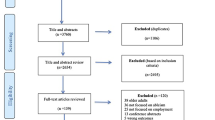Abstract
The challenge of youth employment is not new. Even in good economic times, young people experience unemployment rates that are 3–4 times higher than adults. More than three out of four of the world’s young workers have informal jobs, while young people are overrepresented in working poverty and less protected forms of work, such as temporary and gig employment. During economic crises, the situation for young people in the labour market deteriorates much faster than for adults and persists for longer periods. The scarring effects for youth were clear after the global financial crisis (GFC) of 2008–09. Beyond these negative trends, it is important to recognise where countries have done much better in getting young people into decent and productive employment, including in the wake of crises. The success of European countries in tackling youth unemployment and inactivity has led to many attempts to replicate the policy approach, which involves integrated programmes such as the EU Youth Guarantee. However, there are major constraints to applying such an approach in developing countries and emerging economies. Against this background, the paper reviews the longer run trends in youth employment, along with the impact of crises on young people, focusing on the COVID-19 pandemic, in both advanced and developing countries. Next, it explores the lessons learned on how best to deal with youth employment challenges drawing from recent global meta-analyses. While the paper highlights that not all lessons can be extrapolated, it is important that countries develop integrated youth employment strategies that address job creation, quality of jobs, and inclusion.
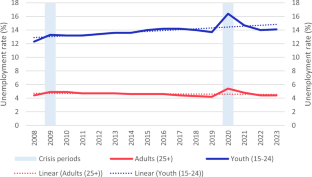
Source: ILO modelled estimates (November 2022), ilostat.ilo.org
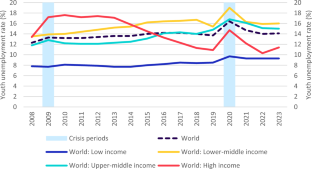
Source: ILO modelled estimates (November 2022), ilostat.ilo.org

Source: ILO modelled estimates (November 2022), ilostat.ilo.org

Source: ILO modelled estimates (November 2022), ilostat.ilo.org. Notes: Other NEET = young people who are neither in employment, education or training, excluding the unemployed. OLF Other out-of-the-labour force, excluding those covered by Other NEET (i.e., excluding the potential labour force)
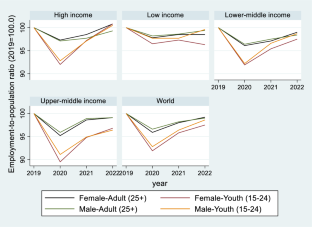
Source: ILO modelled estimates (November 2022), ilostat.ilo.org; author’s calculations

Source: ILO modelled estimates, ilostat.ilo.org; author’s calculations.
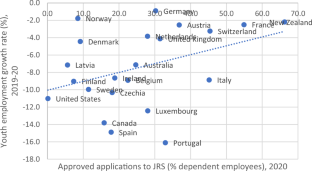
Source: Approved applications to job retention schemes as a share of dependent employees – OECD (2020); youth employment growth rate – authors’ calculations, labour force surveys, ilostat.ilo.org
Similar content being viewed by others
Notes
Resolution concerning statistics of work, employment and labour underutilization (ilo.org).
National data sourced from ilostat.ilo.org.
ILO modelled estimates, ilostat.ilo.org.
Source: Periodic Labour Force Survey, accessed from ilostat.ilo.org.
This takes into account population trends that are particularly important in developing countries (where the denominator changes more rapidly than in advance economies).
See ILO (2020) ILO Monitor: COVID‑19 and the World of Work – Second Edition, 7 April 2020 for more details on how the ILO classified at-risk sectors.
Federal Employment Agency, “Realisierte Kurzarbeit (hochgerechnet) Deutschland, Länder, Regionaldirektionen, Agenturen für Arbeit und Kreise (Monatszahlen)” database (accessed February 2023).
United States Bureau of Labor Statistics, “Unemployed Persons by Reason for Unemployment, Seasonally Adjusted”, Labor Force Statistics from the Current Population Survey. https://www.bls.gov/web/empsit/cpseea11.htm (accessed May 2021).
The reinforced Youth Guarantee—Employment, Social Affairs & Inclusion—European Commission (europa.eu).
References
Barford, A., A. Coutts, and G. Sahai. 2022. Youth employment in times of COVID: A global review of COVID-19 policy responses to tackle (un)employment and disadvantage among young people. Geneva: ILO.
Card, D., J. Kluve, and A. Weber. 2018. What works? A meta analysis of recent active labor market program evaluations. Journal of the European Economic Association 16 (3): 894–931.
Eichhorst, W., P. Marx, U. Rinne, and J. Brunner. 2022. Job retention schemes during COVID-19: A review of policy responses. Geneva: ILO.
Federal Ministry of Labour Austria. 2022. Jugend und Arbeit in Österreich - Berichtsjahr 2020/2021. Vienna
ILO. 2017. Global employment trends for youth 2017. Geneva: ILO.
ILO. 2022. ILO monitor on the world of work, 10th ed. Geneva: ILO.
ILO. 2021. Briefing note: An update on the youth labour market impact of the COVID-19 crisis.
Kahn, L.J. 2010. The long-term labor market consequences of graduating from college in a bad economy. Labour Economics 17 (2): 303–316.
Kluve, J., S. Puerto, D. Robalino, J.M. Romero, F. Rother, J. Störeau, F. Weidenkaff, and M. Witte. 2018. Do youth employment programs improve labor market outcomes? A quantitative review. World Development 114 (237): 253.
OECD. 2020. Job Retention schemes during the COVID-19 lockdown and beyond. Paris: OECD.
Rinne, U., W. Eichhorst, P. Marx, and J. Brunner. 2022. Promoting youth employment during COVID-19: A review of policy responses. Geneva: ILO.
Schwandt, H., and T. von Wachter. 2019. Unlucky cohorts: estimating the long-term effects of entering the labor market in a recession in large cross-sectional data sets. Journal of Labor Economics 37 (S1): S161–S198.
Verick, S., D. Schmidt-Klau, and S. Lee. 2022. Is this time really different? How the impact of the COVID-19 crisis on labour markets contrasts with that of the global financial crisis of 2008–09. International Labour Review 161 (1): 125–148.
Funding
There is no funding for this article.
Author information
Authors and Affiliations
Corresponding author
Ethics declarations
Conflict of interest
There is no conflict of interest for this article.
Additional information
Publisher's Note
Springer Nature remains neutral with regard to jurisdictional claims in published maps and institutional affiliations.
The views expressed in this article do not necessarily represent those of the ILO.
Throughout this paper, unless stated otherwise, young people refer to those aged 15 to 24 years.
Rights and permissions
Springer Nature or its licensor (e.g. a society or other partner) holds exclusive rights to this article under a publishing agreement with the author(s) or other rightsholder(s); author self-archiving of the accepted manuscript version of this article is solely governed by the terms of such publishing agreement and applicable law.
About this article
Cite this article
Verick, S.S. The Challenge of Youth Employment: New Findings and Approaches. Ind. J. Labour Econ. 66, 421–437 (2023). https://doi.org/10.1007/s41027-023-00438-5
Accepted:
Published:
Issue Date:
DOI: https://doi.org/10.1007/s41027-023-00438-5




